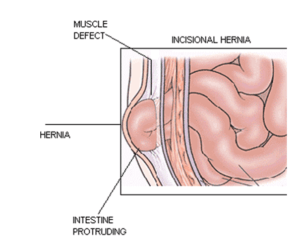A bulge at the operated site, laxity of abdominal muscles, excess of fat in the abdominal wall or generalized distention, all these mean a ‘prominent belly’ for the patient. Incisional Hernia is a very important surgical entity that needs careful individualised assessment and management, says Consultant General Surgeon, Dr.G.Sivakumar, who explains in lucid terms all about Incisional hernia.
What is Incisional Hernia?
A hernia is a protrusion of an internal organ through an abnormal opening or a defect in the abdominal wall. In an Incisional Hernia or Ventral Hernia, the defect is usually at the operative incision. This may result in the intestine protrudes, creating a visible bulge. Hernias commonly develop in women usually around the umbilicus or a surgical incision of the previous operation.
It is usually because of weakness in the abdominal wall muscles. These are caused by excessive straining, obesity, heavy work, persistent cough in the postoperative period or poor suture materials. The abdominal wall is nicely structured with centrally placed Rectus muscles. This muscle is unique in its ability to contract isometrically to withstand raised intra-abdominal pressures. When the muscle is wasted due to lack of exercise, obesity, repeated pregnancies or surgeries, it gives way.
What makes one suspect a Hernia?
A lump or swelling may be seen or felt in the old operative site. If the swelling disappears when you lie down, there is probably a hernia. You may feel discomfort, an ache, pressure or pain in the area. The pain typically gets worse with prolonged standing or with heavy work.
Many conditions can mimic hernia. Laxity and splaying of the muscles can weaken the entire abdominal wall. This is called ‘divarication of rectus muscle’. This condition needs only ‘leg raising’ abdominal wall exercises. More serious of all is abdominal distention due to intra-abdominal diseases. They are referred to as 5 Fs , viz fat, flatus, fluid, fetus and feces. Morbid obesity and fat-laden abdominal wall may be mistaken for a hernia or on many occasions co-exist with an incisional hernia.some may be very obese that they may know about the hernia only when complications occur.
What are the complications of Hernia?
A hernia is a defect and it does not get better on its own. If left untreated, it gradually gets worse, and become larger. Severe pain may indicate ‘strangulation’ of the hernial contents. This is a serious situation and may require emergency surgery.
What are the various surgical options available to treat Hernia?
Wearing a truss or binder gives only temporary relief and is not usually recommended The only treatment is surgery. There are many surgical techniques. Surgery is time tested and has minimal post-operative discomfort, faster recovery, and permanent cure. The traditional open surgery and the laparoscopic method are available. When there is an excess of subcutaneous fat tummy tucking ( lipectomy) is useful and is of good cosmetic value too.

When is surgery done?
‘Stitch in time saves nine’. Timely surgery is very crucial. The patient is prepared for the surgery. Adequate pre-operative rectus muscle exercises are very important for a successful outcome. The patient is advised to lose weight. Respiratory care is essential as a cough can disrupt sutures. Any local sepsis is controlled. The patient is counselled for future pregnancies as they might disrupt a nice repair.
What is mesh insertion ?
Mesh is made of synthetic polypropylene or PTFE that reinforces the weak abdominal wall. These are stitched to the fascial layers in open or in laparoscopic surgeries.
In the days when hi-tech imaging investigations are available, the abdomen is opened only when it is essential and Minimal access surgeries like laparoscopic surgeries are performed when feasible. This will reduce many incisional hernias.
Postoperative advice :
- Unaccustomed heavy work should be avoided.
- Cough in the Postoperative period needs prompt treatment.
- Protective Corsets and belts are of questionable value and adequate gradual exercises to develop good abdominal muscles is important.
- Bodyweight should be kept under control.
